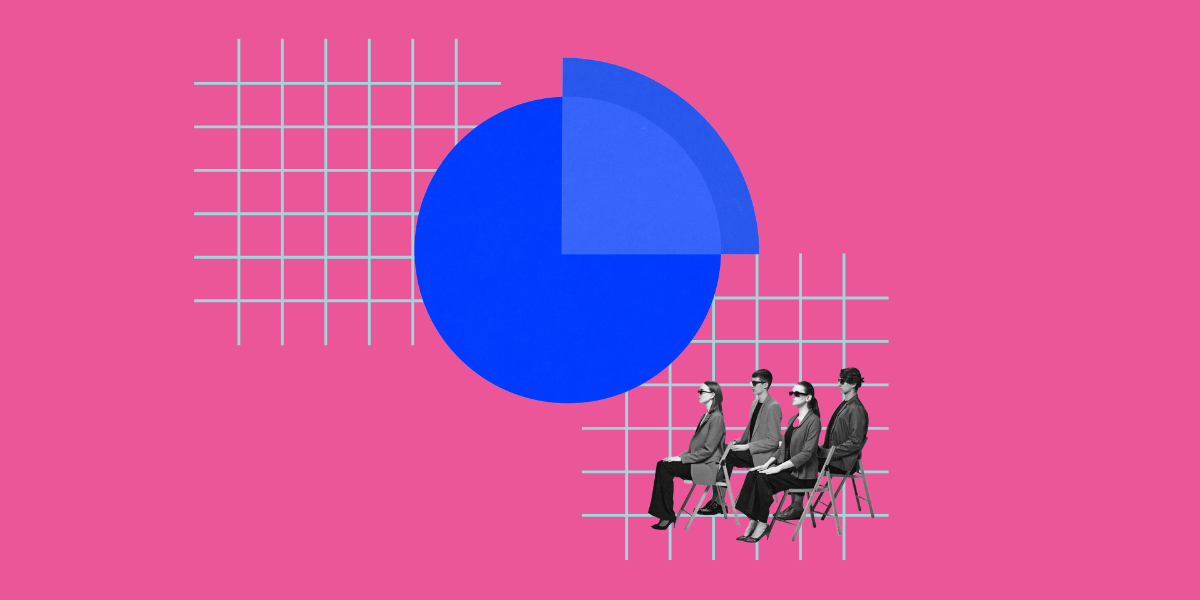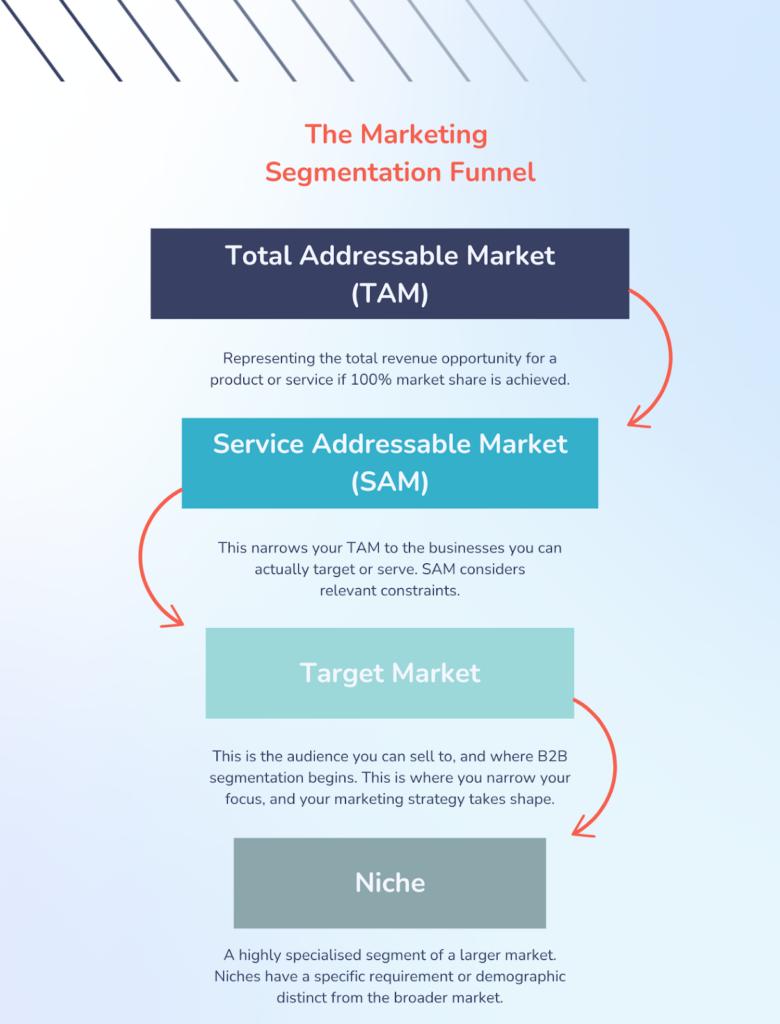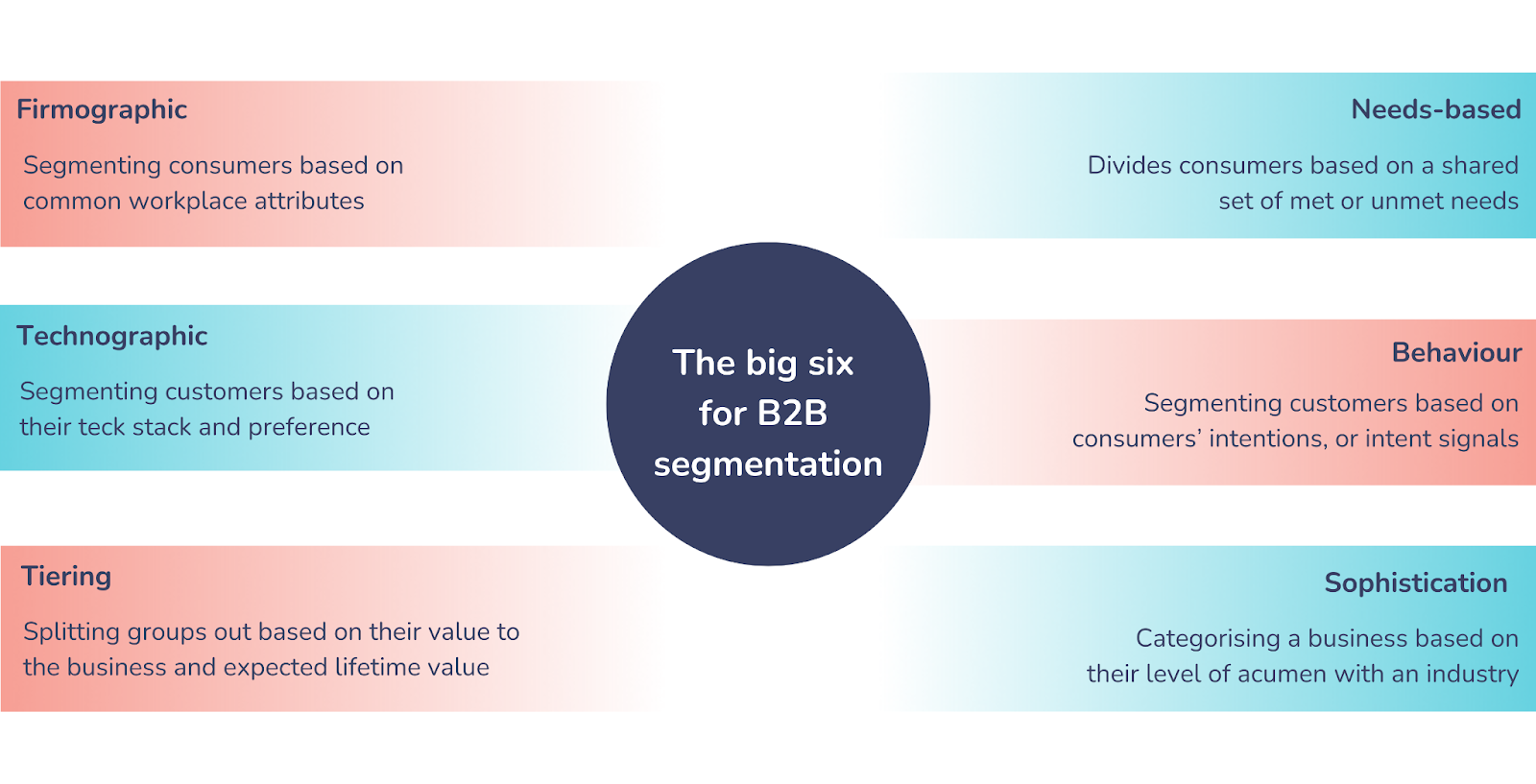B2B market segmentation: Your step-by-step guide
In this blog
- What is B2B market segmentation?
- The market segmentation funnel
- Segmentation by buyer stage
- The difference between B2C and B2B segmentation
- The importance of B2B segmentation
- B2B customer segmentation methods
- How to segment your B2B market
- An extreme market segmentation example
- Find and segment your ideal customers with Sopro

What is B2B target market segmentation, why must you do it, and what customer segments can you apply to your business?
The three core business principles are having a product that solves a problem, knowing who needs your solution, and differentiating yourself from competitors.
How do you smash those three things? Market segmentation is one of the most crucial weapons in your arsenal.
Effective segmentation allows you to accurately identify, target, and reach your customers, and then tailor your messaging to resonate with different audience segments.
In this guide, we’ll show you the various options to understand the differences in your customer base and how you can build your customer segmentation strategy.
What is B2B market segmentation?
B2B market segmentation focuses on finding unique audience segments by revealing common characteristics. Businesses can better connect with potential customers by understanding similar traits, needs, and behaviours. It allows you to prioritise resources, tailor messaging, develop products, and amend sales processes.
Without B2B market segmentation, you risk treating everyone as the same. Great if your targets are as different as a replicating Matrix agent, but not so good if they are real people.
If you don’t bother to segment, your marketing probably won’t connect well with anyone. A wise marketeer once said, “What is marketing if not segmentation?”
But there isn’t a one-size-fits-all approach to dividing your audience. Let’s dig a little deeper into the aspects of market segmentation.
The market segmentation funnel
Oh yay! Who doesn’t love a marketing funnel? This should help you visualise the narrowing of your audience as you segment, from everyone that could buy in theory, to specific groups within that.

Total addressable market (TAM)
Right at the top, you have your total addressable market. This represents the total revenue opportunity for a product or service if 100% market share is achieved. It’s the broadest view of the market and doesn’t consider any segments.
Serviceable available market (SAM)
This segment narrows your TAM to the businesses you can actually target or serve. SAM considers relevant constraints such as geography or regulations to define the part of TAM your business can access.
Target market
Your target market is used to address niches within your total addressable market. At this point, you’ve recognised the audience you can sell to, and identifying your target markets is where that B2B segmentation begins. This is the stage where you narrow your focus, and your marketing strategy starts to take shape.
Niche
A niche is a highly specialised segment of a larger market. Niches have a specific requirement or demographic distinct from the broader market. Businesses can find niches where competition is less intense, and customer needs are more specific.
Content can be specifically produced to support different client interests and preferences – this will help with those conversion rates.
Segmentation by buyer stage
Segmenting accounts by where they sit in the sales funnel can help businesses tailor content that can nurture leads and help close more deals.
Engaged accounts
Focus on educational content that positions you as an expert, addresses their pain points and introduces your solutions. The goal is to build trust and establish authority.
Opportunities
Shift to more personalised content. Alongside tailored proposals and demos, things like case studies and battle cards can demonstrate the value of your solution for their specific needs. At this point, your content should aim to reach all decision-makers in the buying process.
Customers
To extend that customer lifetime value and loyalty, it’s important to keep nurturing the relationship. Provide onboarding materials and ongoing support to ensure they get maximum value from their purchase, encouraging satisfaction and loyalty.
The difference between B2C and B2B segmentation
So, what’s the difference between customer segmentation for B2B and B2C businesses? It all comes down to the difference in motivations, processes and considerations between B2B and B2C buyers.
B2B markets have multiple decision-makers
In a B2C setting, your target customers are individuals or families. In B2B businesses, you will likely have multiple decision-makers signing off on a purchase decision. Our research found that there are now an average of four buyers in the decision-making process, with 11% of companies having more than ten people!
B2B products and services are often more complex
Businesses often have a complex mesh of products and systems. The difficulty embedding or extracting products from this tangled web changes the buying process.
B2B decision-makers go through a more rational process
A family will discuss where to go on their next holiday. They are unlikely to go through a formal due diligence process, with little Johnny assigned as the family’s compliance officer. The complexity of the products and the responsibility to spend the budget wisely mean formal processes often exist.
The buying cycle is different
B2C purchases tend to be short-term, with a few notable exceptions. B2B purchases tend to be long-term or at least have the possibility to repeat. The difficulty of embedding and extracting means change is not always welcomed.
B2B target audiences are smaller
B2C companies are likely to have thousands upon thousands of customers. In the B2B sphere, a small number of clients will likely make up the majority of revenue.
Personal relationships matter more
B2B sales often involve face-to-face interactions such as handshakes, dinners, business cards, and expenses. Deciding which prospects and clients should get the full personal service is one of the outcomes of B2B customer segmentation.
The importance of B2B segmentation
It goes without saying that by segmenting your B2B target market, you’re more likely to reach those who need your product or service. In fact, 80% of companies that use market segmentation have reported that they see an uplift in sales.
But just in case you need a little more convincing, here’s a breakdown of why B2B market segmentation is so valuable:
- Helps you to develop customer insights
Rule one of business: know your customers. By recognising niche segments, your business can refine strategies to make them fit your market. It can help with marketing, sales and even research and development.
- Improve marketing results
A more focused marketing strategy will allow you to speak to the right people, tailor your content and add a layer of personalisation to your outreach. Did you know? 74% of marketers experience higher engagement when harnessing the power of personalisation.
- Win higher quality leads
If one of the benefits of customer segmentation is more effective marketing, one of the effects of that is higher quality leads.
Using lead scoring, you can watch as your increasingly targeted marketing brings in more relevant prospects. You can also track lead rates, number of pitches, time taken to close deals (lead to sale), and closed won deals to gain further insights into audience segments.
Better leads? Higher conversions! By segmenting target markets, companies have doubled their conversion rates.
- Improve customer retention
With refined segmentation comes elevated marketing efforts and higher-quality leads! With any luck, this will drive up your customer retention rates (and, therefore, their lifetime value).
- Brand loyalty and referrals
A strong marketing segmentation strategy focuses on customers more likely to advocate for your brand. More satisfied customers lead to glowing reviews, and you can harness the power of those recommendations and build a referral marketing strategy.
B2B customer segmentation methods
It should be clear by now that there are many types of market segmentation methods, but some are more commonly used.
Categorise them in a way that benefits both your sales and marketing teams and then curate a customer experience that is seamless, personalised and, importantly, boosts conversion rates.

Firmographic segmentation
Firmographics is the starting point to help you achieve heightened levels of personalisation. However, it has less to do with the individual demographics and is focused more on the information you can find about a specific company.
Typical types of firmographic data you can expect to collect include company size, industry type, operating locations, revenue, and growth trends. Firmographics tend to overlap with demographics – together, they provide valuable insights into the organisation and decision-making units.
Typically, this will include information such as company size, number of employees, industry overviews, funding streams and revenue.
Where to find firmographic information
The quickest way to find a lot of this information is by checking out their website or social media (LinkedIn is a quick win) – a lot of information will be available first-hand.
You can also survey companies and find more information in those first prospecting steps. It’s important to ask the right questions about revenue and market share.
And don’t forget! You can work with the experts to help you delve deeper into the nitty gritty. We consider ourselves the data experts with a whole team on hand to help – and that’s why we know that buying bought lists isn’t your best bet either.
Technographic segmentation
Technographic segmentation involves dividing B2B markets based on the technology profiles of companies.
By analysing technographic data, you can gain insights into the tools, software, and platforms utilised by their target audience. This enables you to create highly targeted and personalised campaigns that resonate with the needs and preferences of different segments within the B2B market.
Ultimately, technographic segmentation helps you optimise your marketing efforts by ensuring you deliver the right messages to the right prospects, increasing the likelihood of engagement and conversion.
Where to find technographic information
Beyond sending out surveys, which commonly yield a low response rate, it requires some tech knowledge. You can scrape their website to find out what tools or software a company uses – but this is a little harder to do in this age of the Internet.
Alternatively, work with a third party who can provide data-compliant information and give you a broad view of the inner workings of a business *cough**cough* Sopro!
Tiering segmentation
Tier-based B2B market segmentation involves categorising prospective customers based on their potential value to the business.
This method considers factors such as average customer lifetime value, acquisition channel efficiency, and lead quality. Businesses can allocate resources effectively by assigning tiers to leads, focusing on high-value prospects and tailoring marketing efforts accordingly.
This approach is often utilised in account-based marketing (ABM), where marketing and sales teams collaborate to target a select number of accounts with personalised strategies.
Using segmentation strategies such as this enables businesses to prioritise their efforts. In turn, seeing a return on investment and enhance overall efficiency in lead generation and conversion activities.
How do you do segment by tiers?
One of the easiest ways to segment your market by tiers is to work the magic of lead scoring.
Lead scoring assigns value to prospects according to their move from expressing initial interest to revealing purchase intent. It tracks their journey through the sales funnel and assesses their likelihood of converting to a sale. It’s also a good idea to include customer lifetime value in your calculations.
Needs-based segmentation
Needs-based segmentation involves grouping customers based on their specific needs and attitudes towards a product or service.
Unlike firmographics, this method focuses on subjective factors, allowing businesses to tailor their marketing strategies to address distinct buying motivations. By understanding different customer segments’ pain points and requirements, companies can develop targeted campaigns. It can help resonate with groups such as ‘productivity focused’ or ‘budget conscious’.
Needs-based segmentation enables businesses to create personalised customer journeys with relatable messaging, fostering brand loyalty and increasing the likelihood of conversions. Another positive outcome of identifying these trends is that it will help you evolve your product or service.
How do you identify the needs of your market?
Although it is challenging to accurately identify prospect needs, conducting interviews with existing customers can provide valuable insights.
However, collecting data from demographic segmentation and understanding buying behaviours will go a long way here. Data that can help with understanding needs include:
- Age
- Size of the market
- Buying patterns
- Spending power
- State of the market currently
- Analysing competitors
Sophistication segmentation
This refers to categorising businesses based on their level of understanding, expertise and familiarity with the products, services, and industry in which they operate.
This segmentation approach acknowledges that B2B customers vary widely in their knowledge and experience, ranging from novices to industry experts. By identifying and understanding these differences, you can tailor your marketing, sales, and support strategies to effectively engage and serve each segment.
For instance, highly sophisticated B2B customers may require detailed technical specifications, advanced features, and specialised solutions.
In contrast, less sophisticated customers may need more guidance. This is an indicator to provide them with educational resources and simplified product offerings. It will go a long way in helping navigate the purchasing process and understand the value proposition.
Understanding the level of sophistication
It’s important not to assume anything about a business. For example, just because they’re a start-up doesn’t mean they have no idea about the benefits of using a CRM. This is where lead nurturing and relationship-building come into play.
Make your prospects feel heard, seen and valued to understand how they operate – and how you can benefit them.
Behavioural segmentation
Tracking buyer intent is one of our specialities here at Sopro and is an insightful tool that should not be overlooked!
It includes keeping tabs on the channels prospects visit you through, what content they interact with and how they interact with your product.
Behavioural segments provide clear insights into what buyers want. Firmographic data can be added to these insights from website analytics, CRM data, or first-hand research. Your strategy is then based on a mix of who the prospect is, what they want, and how they behave.
Tracking intent in this way helps your teams identify when a buyer is actively engaged in your industry. This can include anything from the research stage to nearing a purchasing decision. You can then reach them at the right time and place with the right message.
Understanding buyer intent
To get a full picture of the power of intent and using behaviour signals, take a look at our in-depth buyer intent guide.
How to segment your B2B market
Step 1: Define Your TAM and target market
- Start by identifying the market you aim to target, setting the stage for deeper segmentation. By calculating your TAM, you can estimate your market’s growth potential. This can be calculated through top-down, bottom-up or through value-theory.
Step 2: Identify segmentation criteria
- Choose relevant B2B segmentation bases that align with your business goals and market realities. Above all, they must be measurable, substantial, accessible, differentiable and actionable.
Step 3: Conduct market research
- Employ surveys, industry reports, customer data, and interviews to gather essential insights. Market Research is invaluable, can provide insights into customer needs, helps you stay competitive, and is integral to measuring success.
Step 4: Segment your market
- Use the gathered criteria to divide the market into distinct segments. It is essential to elevate personalised outreach, which will make a real difference in lead and conversion rates.
Step 5: Develop profiles for each segment
- Craft detailed personas for each identified segment, focusing on Ideal Customer Profiles (ICPs) to guide content creation and marketing strategies. Having a strong idea of who you’re targeting will benefit outreach for both your sales and marketing teams.
Step 6: Tailor your marketing strategies
- Create marketing strategies that cater to each segment’s specific needs and characteristics, using ICPs and personas as foundational elements. This will help you to reach your audience in the right place and with the right message.
Step 7: Monitor and adjust
- Continuously assess the performance of each segment and the overall market dynamics. Be prepared to update your segmentation and strategies as needed to stay aligned with market changes.
An extreme market segmentation example
To illustrate how central segmentation can be, pop on your headphones, head over to the world of B2C, and fire up Spotify. How did they become the market leader when all of their competitors offer the same music?
Spotify takes segmentation to the extreme, a key part of product development as well as marketing. It started with a giant exercise in “people who liked this also like…”, developed into expert-curated playlists, machine learning algorithms that categorise music into 5,000 distinct genres, and finally AI that curates hundreds of personalised playlists for each user daily.
Find and segment your ideal customers with Sopro
Segmenting your prospective customers is a big job. However, it’s a crucial part of getting the right message in front of the right people.
So leaving your sales outreach to the experts is a logical choice if you’re spending more time segmenting than selling.
With Sopro, finding and connecting with your ideal customers is a breeze. Our fully managed service uses smart technology and up-to-the-minute data to find and engage your perfect prospects. So you can sit back and watch those high-quality leads roll in.
More touchpoints, more engagement, more time to sell. See how our prospecting service works.




Share